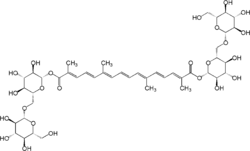Crocin
 | |
| Names | |
|---|---|
| IUPAC name
Bis[(2S,3R,4S,5S,6R)-3,4,5-trihydroxy-6-({[(2R,3R,4S,5S,6R)-3,4,5-trihydroxy-6-(hydroxymethyl)tetrahydro-2H-pyran-2-yl]oxy}methyl)tetrahydro-2H-pyran-2-yl] (2E,4E,6E,8E,10E,12E,14E)-2,6,11,15-tetramethyl-2,4,6,8,10,12,14-hexadecaheptaenedioate | |
| Identifiers | |
| 42553-65-1 | |
| 3D model (Jmol) | Interactive image |
| ChEBI | CHEBI:79068 |
| ChemSpider | 4444645 |
| ECHA InfoCard | 100.050.783 |
| PubChem | 5281233 |
| |
| |
| Properties | |
| C44H64O24 | |
| Molar mass | 976.97 g·mol−1 |
| Except where otherwise noted, data are given for materials in their standard state (at 25 °C [77 °F], 100 kPa). | |
| Infobox references | |
Crocin is a carotenoid chemical compound that is found in the flowers crocus and gardenia.[1] Crocin is the chemical ingredient primarily responsible for the color of saffron.
Chemically, crocin is the diester formed from the disaccharide gentiobiose and the dicarboxylic acid crocetin. When isolated as a pure chemical compound, it has a deep red color and forms crystals with a melting point of 186 °C. When dissolved in water, it forms an orange solution.
The term crocins may also refer to members of a series of related hydrophilic carotenoids that are either monoglycosyl or diglycosyl polyene esters of crocetin.[2][3] The crocin underlying saffron's aroma is α-crocin (a carotenoid pigment that may comprise more than 10% of dry saffron's mass.) : trans-crocetin di-(β-D-gentiobiosyl) ester; it bears the systematic (IUPAC) name 8,8-diapo-8,8-carotenoic acid. [2]
The major active ingredient of saffron is the yellow pigment crocin 2 (three other derivatives with different glycosylations are known) containing a gentiobiose (disaccharide) group at each end of the molecule. The five major biologically active ingredients of saffron, namely the four crocins and crocetin, can be measured with HPLC-UV.[4]
Physiological effects on mammalian tissues and organisms
Crocin has been shown to be an antioxidant,[5][6] and neural protective agent.[7][8] The antioxidant behavior of crocin is related to the sugar moiety in crocin molecule which has a vital role in its chemical reactivity.[6] It has also been shown to have an antiproliferative action against cancer cells in vitro.[9][10][11] Limited evidence suggests possible antidepressant properties of crocin in mice[12] and humans.[13] One study reports aphrodisiac properties in male rats at very high doses.[14]
References
- ↑ "Chemical Information". sun.ars-grin.gov. Retrieved 2008-03-02.
- 1 2 Abdullaev 2002, p. 1.
- ↑ Abdullaev, F. I. (2002), "Cancer Chemopreventive and Tumoricidal Properties of Saffron (Crocus sativus L.)", Experimental Biology and Medicine, 227 (1), PMID 11788779, retrieved 11 September 2011
- ↑ Li, Na; Lin, Ge; Kwan, Yiu-Wa; Min, Zhi-Da (July 1999). "Simultaneous quantification of five major biologically active ingredients of saffron by high-performance liquid chromatography". Journal of Chromatography A. 849 (2): 349–355. doi:10.1016/S0021-9673(99)00600-7.
- ↑ Papandreou MA, Kanakis CD, Polissiou MG, Efthimiopoulos S, Cordopatis P, Margarity M, Lamari FN (2006). "Inhibitory activity on amyloid-beta aggregation and antioxidant properties of Crocus sativus stigmas extract and its crocin constituents". J Agric Food Chem. 54 (23): 8762–8. doi:10.1021/jf061932a. PMID 17090119.
- 1 2 Akhtari K; Hassanzadeh K; Fakhraei B; Fakhraei N; Hassanzadeh H; Zarei. S A. (2013). "A density functional theory study of the reactivity descriptors and antioxidant behavior of Crocin". Computational and Theoretical Chemistry. 1013: 123–129. doi:10.1016/j.comptc.2013.03.015.
- ↑ Ochiai T, et al. (2006). "Protective effects of carotenoids from saffron on neuronal injury in vitro and in vivo". Biochim Biophys Acta. 1770 (4): 578–584. doi:10.1016/j.bbagen.2006.11.012. PMID 17215084.
- ↑ Zheng YQ, Liu JX, Wang JN, Xu L (2006). "Effects of crocin on reperfusion-induced oxidative/nitrative injury to cerebral microvessels after global cerebral ischemia". Brain Res. 1138: 86–94. doi:10.1016/j.brainres.2006.12.064. PMID 17274961.
- ↑ Escribano J, Alonso GL, Coca-Prados M, Fernandez JA (1996). "Crocin, safranal and picrocrocin from saffron (Crocus sativus L.) inhibit the growth of human cancer cells in vitro". Cancer Letters. 100 (1–2): 22–30. doi:10.1016/0304-3835(95)04067-6. PMID 8620447.
- ↑ Chryssanthi DG, Lamari FN, Iatrou G, Pylara A, Karamanos NK, Cordopatis P (2007). "Inhibition of breast cancer cell proliferation by style constituents of different Crocus species". Anticancer Research. 27 (1A): 357–62. PMID 17352254.
- ↑ Abdullaev Jafarova F, Caballero-Ortega H, Riverón-Negrete L, Pereda-Miranda R, Rivera-Luna R, Manuel Hernández J, Pérez-López I, Espinosa-Aguirre JJ (2002). "In vitro evaluation of the chemopreventive potential of saffron". Rev. Invest. Clin. 54 (5): 430–6. PMID 12587418.
- ↑ Hosseinzadeh, H; Jahanian, Z (2010). "Effect of Crocus sativus L. (saffron) stigma and its constituents, crocin and safranal, on morphine withdrawal syndrome in mice". Phytotherapy research : PTR. 24 (5): 726–30. doi:10.1002/ptr.3011. PMID 19827024.
- ↑ Akhondzadeh, S; Fallah-Pour, H; Afkham, K; Jamshidi, AH; Khalighi-Cigaroudi, F (2004). "Comparison of Crocus sativus L. And imipramine in the treatment of mild to moderate depression: A pilot double-blind randomized trial ISRCTN45683816". BMC Complementary and Alternative Medicine. 4: 12. doi:10.1186/1472-6882-4-12. PMC 517724
 . PMID 15341662.
. PMID 15341662. - ↑ Hosseinzadeh H, Ziaee T, Sadeghi A (June 2008). "The effect of saffron, Crocus sativus stigma, extract and its constituents, safranal and crocin on sexual behaviors in normal male rats". Phytomedicine. 15 (6–7): 491–5. doi:10.1016/j.phymed.2007.09.020. PMID 17962007.